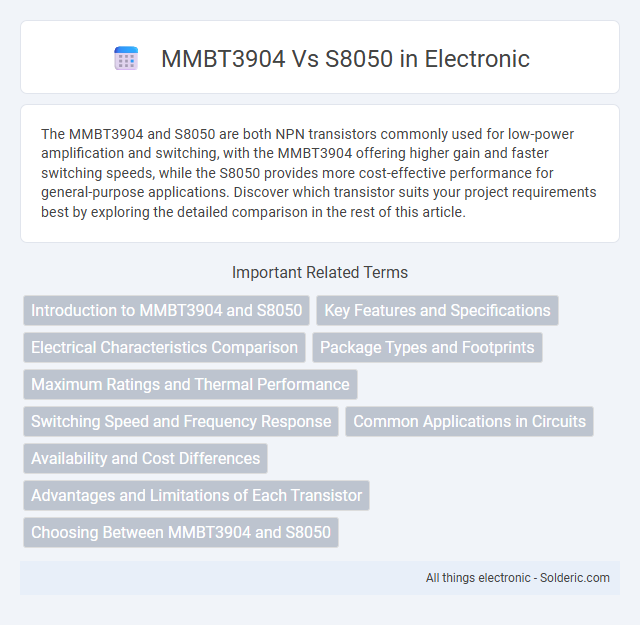The MMBT3904 and S8050 are both NPN transistors commonly used for low-power amplification and switching, with the MMBT3904 offering higher gain and faster switching speeds, while the S8050 provides more cost-effective performance for general-purpose applications. Discover which transistor suits your project requirements best by exploring the detailed comparison in the rest of this article.
Comparison Table
| Feature | MMBT3904 | S8050 |
|---|---|---|
| Type | NPN Bipolar Junction Transistor (BJT) | NPN Bipolar Junction Transistor (BJT) |
| Package | SOT-23 (Surface-mount) | SOT-23 (Surface-mount) |
| Collector-Emitter Voltage (Vce) | 40 V | 25 V |
| Collector Current (Ic) | 200 mA | 700 mA |
| Power Dissipation (Pd) | 350 mW | 625 mW |
| Gain Bandwidth Product (fT) | 300 MHz | 100 MHz |
| Typical Gain (hFE) | 100 - 300 | 120 - 300 |
| Applications | Switching, general-purpose amplification, low noise circuits | Switching, low power amplification, audio circuits |
Introduction to MMBT3904 and S8050
MMBT3904 and S8050 are widely used NPN bipolar junction transistors known for their general-purpose amplification and switching capabilities. The MMBT3904 is a high-frequency transistor with a transition frequency (fT) of up to 300 MHz, making it suitable for low noise and high-speed applications. The S8050, with a lower fT around 150 MHz, is favored for low power switching and amplification in consumer electronics and signal processing circuits.
Key Features and Specifications
The MMBT3904 is a NPN bipolar junction transistor with a maximum collector current of 200mA and a transition frequency (fT) of 300MHz, ideal for high-frequency switching applications. The S8050 is also an NPN transistor but supports a higher collector current up to 1.5A and a lower transition frequency around 100MHz, suitable for general-purpose amplification and switching. Both transistors operate within a voltage range of 40V collector-emitter, but the S8050 features a larger gain bandwidth product and higher power dissipation, making it more robust for power-intensive tasks.
Electrical Characteristics Comparison
The MMBT3904 and S8050 transistors differ significantly in electrical characteristics, with the MMBT3904 typically offering a higher collector current of up to 200mA compared to the S8050's 1.5A, making the latter more suitable for high current applications. The MMBT3904 has a maximum collector-emitter voltage of 40V, whereas the S8050 can handle up to 25V, indicating better voltage tolerance for the MMBT3904. Furthermore, the Gain Bandwidth Product (fT) of the MMBT3904 is around 300MHz, surpassing the S8050's approximate 100MHz, which favors the MMBT3904 in high-frequency circuits.
Package Types and Footprints
The MMBT3904 transistor is commonly available in an SOT-23 package, featuring a compact footprint ideal for surface-mount technology (SMT) applications demanding space efficiency. In contrast, the S8050 typically comes in a TO-92 package, which is larger and through-hole mounted, making it suitable for prototyping or designs where board space is less constrained. Knowing these differences in package types and footprints helps you select the appropriate transistor based on your circuit layout and assembly process requirements.
Maximum Ratings and Thermal Performance
The MMBT3904 offers a maximum collector current (Ic) of 200mA and a maximum collector-emitter voltage (Vce) of 40V, while the S8050 supports a slightly higher collector current up to 500mA but has a lower maximum voltage rating around 25V. Thermal performance shows the MMBT3904 with a junction temperature rating up to 150degC and a typical power dissipation of 625mW, whereas the S8050 typically supports up to 150degC but dissipates slightly higher power at around 800mW. For efficient thermal management in your circuit designs, it is crucial to consider these maximum ratings to prevent device failure under high current or voltage stress.
Switching Speed and Frequency Response
MMBT3904 transistors offer faster switching speeds and higher frequency response compared to S8050, making them more suitable for high-frequency applications such as RF circuits and fast switching in digital electronics. The S8050, while reliable for general-purpose low-speed switching, exhibits slower transition times and limited frequency bandwidth. Choosing MMBT3904 can enhance your circuit's performance where rapid switching and frequency handling are critical.
Common Applications in Circuits
The MMBT3904 is commonly used in low-power switching and amplification circuits due to its high gain and reliable switching performance, making it ideal for signal amplification and small load driving. The S8050 transistor is frequently found in general-purpose amplification and switching applications, favoring low voltage and moderate current circuits such as LED drivers and audio amplifiers. Your choice depends on the specific current and voltage requirements in your circuit design, with the MMBT3904 offering better high-frequency response compared to the S8050.
Availability and Cost Differences
MMBT3904 transistors are widely available through major electronics suppliers and generally cost slightly more than S8050 transistors due to their higher performance specifications. S8050 transistors, commonly found in consumer electronics, are more abundant in local markets and offer budget-friendly pricing, making them suitable for cost-sensitive projects. Your choice between these two should consider availability in your region and the overall impact on project budget and supply chain reliability.
Advantages and Limitations of Each Transistor
The MMBT3904 offers higher frequency response and better gain bandwidth, making it suitable for high-speed switching and amplifier applications, while its smaller SOT-23 package enables efficient PCB space utilization. The S8050 excels in higher current handling capacity and greater robustness under higher voltage conditions, making it ideal for general-purpose amplification and switching in power circuits. Limitations of the MMBT3904 include lower maximum current rating compared to the S8050, whereas the S8050's slower transition frequency and larger package size may restrict high-frequency performance.
Choosing Between MMBT3904 and S8050
Choosing between MMBT3904 and S8050 transistors depends on voltage, current ratings, and switching speed requirements. MMBT3904 offers a higher collector current of up to 200mA and a maximum voltage rating of 40V, suitable for general-purpose amplification and switching. S8050 supports a collector current up to 1.5A and a voltage rating of 25V, making it ideal for higher current applications requiring robust switching performance.
MMBT3904 vs S8050 Infographic

 solderic.com
solderic.com